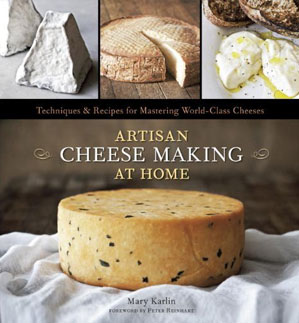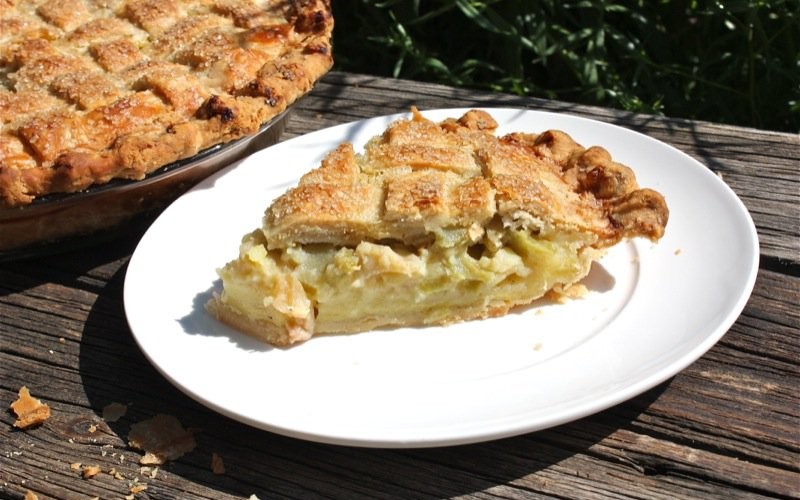“Confidence is preparation. Everything else is beyond your control.”
Richard Kline, OR for those of you not so inclined:
“[Preparation] will dull your mind and destroy the potential for authentic creativity.” A Beautiful Mind
As Mary writes, just a century ago, cheese was still a relatively regional and European phenomenon and cheese making techniques had their geographic limitations. I can testify to that as recently as 2002 when visiting the former Yugoslavia, the only cheeses available in their “œsupermarkets” were a very basic four international choices: Edam, Swiss, Emmentaler, and Gouda. There were cheeses available that I had never heard of that were native to the culture, but not many. Most of these cheeses were still made at home. There was one salad on the menu at every restaurant, everywhere, at that time: Srbski Salad. It came with cheese. When asked what kind of cheese was on the salad, the waiter eyed me with suspicious disdain and hissed, “œCheese-cheese!” and marched away.
The rise of the humble loaf of bread with four simple ingredients: yeast (or a leavening agent), water, salt and flour has been elevated to its artisanal platform through our very recent modern era by travel and technology. This has also spurned Artisanal cheese makers to hone their craft through four equally simple ingredients: milk, starters, coagulants and salt.
Home cooks all over North America are as excited about this new learning as bakers and cheese makers. Mary Karlin professes that this is “not only achievable, but a fascinating and rewarding process.”
What better opportunity than now for Cheesepalooza?
Buy the book: Artisan Cheese Making At Home by Mary Karlin
- it is available in hard cover, in e-book, or i-book (for i-pod and i-pad only)
Preparation:
Read the first chapter of the book, or read the outline below, or just wait for the first challenge to be posted and wing it: whatever your style is, we hope to accommodate it!
Cheese Making Basics and Supplies
- Supplies (do not go and buy them all; read the note to follow0
- Butter muslin ““ 4 to 6 metres
- Cheesecloth ““ 4 to 6 metres
- Plastic colander of strainer (non-reactive material)
- Cutting boards
- Disposable food gloves
- Non-reactive draining bucket for catching up to 2 gallons or 7.5 litres whey
- Plastic cheese mats to drain molded curds
- Non-reactive draining rack to sit inside draining tray
- Food grade plastic draining trays or rimmed quarter or 1/2sheet baking pans
- Flexible wire stainless steel whisk with a long handle
- Flexible blade rubber spatulas
- Instant read kitchen or dairy thermometers
- Ladle or skimmer for removing curds from whey
- Molding and shaping devices
- Paper towel
- Food grade storage ripening boxes with lids
- Large spoons for stirring: one slotted and one not
- Stainless steel pots:
- one 6 quart pot for working with 1 gallon or 4 litres of milk
- one 10 quart pot for working with 2 gallons or 7.5 litre of milk
- a 12 quart pot for making a water bath for indirect heating
- Stainless steel measuring spoons that include a 1/8 th teaspoon measure
- Wrapping materials, resealable bags, plastic wrap, foil
- Weights: bricks, skillets, etc.
Note: There is an additional list on page 8 for some other recipes, but this list is more than enough to start with as many of these items can be improvised. Advice for this is on page 7 and Ian will be offering more suggestions as we progress.
2. Habits: Keep Batches Small, Set Expectations, Prepare, Be Safe and Sanitary
The Building Blocks of Cheese
- Milk
- Starter Cultures
- Secondary Cultures Molds and Bacteria
- Cultures Chart page 12 and 13
- Coagulants
- Salt Water
- Calcium Chloride
- Lipase Powder
- Vegetable Ash
- Annatto
- Herbs and Spices
Processes and Techniques
- Preparation
- Ripening Milk
- Technique: making and using a hot water bath
- Adding starter cultures
- Technique: whisking in starter cultures and other additives
- Coagulation and Curd Finishing
- Technique: testing for a clean break
- Technique: cutting the curds
- Cooking the curds
- Draining, Shaping and Pressing Curds
- Technique: draining curds in a colander
- Technique: making and using a draining sack
- Technique: draining curds in a mold
- Pressing cheese
- Technique: filling a cheese mold or press for pressed curds
- Technique: flipping cheese during pressing
- Technique; cheddaring
- Salting
- Technique: dry salting
- Technique: brining
- Brine chart page 24
- Drying
- Technique: air drying
- Ripening or Aging
- Technique: controlling unwanted growths
- Technique: using a ripening box
- Ripening caves
- Spirited ripening
- Technique: smoking cheeses
- Technique: waxing cheese
- Technique: bandaging cheese
- Storing
- Guidelines page 30
What is a Mother Culture? page 31
Trouble Shooting pages 32 and 33








Cheese cheese means most likely what it is known worldwide as feta. This is simply cheese in most eastern European countries. And then you start with specialty cheeses that have different names. Feta is the easiest to make and can be made home by almost everybody. The only thing is to want to try.
Arina,
I did learn to know that! Thank you for clarifying… as in Canada, “cheese-cheese” would definitely be an orange cheddar, and in the US, “cheese-cheese” would be the plastic wrapped and processed “American Cheese Slice”.
Hugs,
Valerie